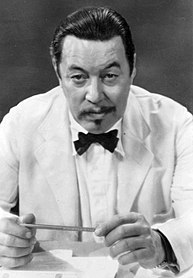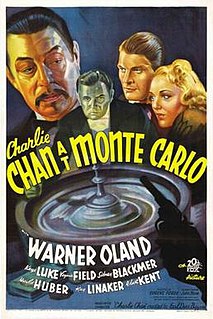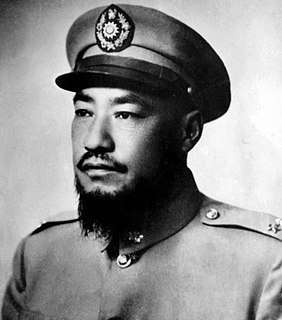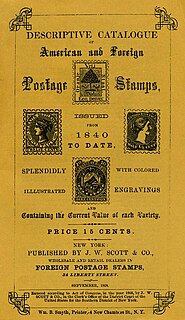
Charlie Chan is a fictional character created by Earl Derr Biggers. Biggers loosely based Chan on Honolulu, Hawaii detective Chang Apana. The benevolent and heroic Chan was conceived of as an alternative to Yellow Peril stereotypes and villains like Fu Manchu. Chan is a detective for the Honolulu police, though many stories feature Chan traveling the world as he investigates mysteries and solves crimes.

A stamp catalog is a catalog of postage stamp types with descriptions and prices.

L'actualité is a Canadian French-language news and general interest magazine published in Montreal by Rogers Communications until 2016, then by Mishmash. The magazine has over a million readers, according to Canada's Print Measurement Bureau, from its circulation which is mainly subscribers. Eighty-six percent of its readership are Québécois.

SPL: Sha Po Lang is a 2005 Hong Kong action film written and directed by Wilson Yip, and starring Donnie Yen, Sammo Hung and Simon Yam. The film was released in Hong Kong on 18 November 2005.

The Red Poppy or sometimes The Red Flower is a ballet in three acts and eight tableaux with an apotheosis, with a score written by Reinhold Glière and libretto by Mikhail Kurilko. This ballet was created in 1927 as the first Soviet ballet with a modern revolutionary theme. Possibly the most famous dance from this ballet is the Sailors Dance, sometimes referred to as the "Russian Sailors Dance". It is this musical selection for which Glière is perhaps best known. There have been four main versions of The Red Poppy.

Charlie Chan at Monte Carlo is a 1937 American movie directed by Eugene Forde. The main character is Charlie Chan, a Chinese-Hawaiian detective. This was the sixteenth and final Charlie Chan film with Warner Oland portraying Chan. The film features Keye Luke as Charlie's son Lee and character actor Harold Huber as a French police inspector.

Ma Bufang (1903 – 31 July 1975) (traditional Chinese: 馬步芳; simplified Chinese: 马步芳; pinyin: Mǎ Bùfāng; Wade–Giles: Ma3 Pu4-fang1, Xiao'erjing: ما بوفنگ) was a prominent Muslim Ma clique warlord in China during the Republic of China era, ruling the province of Qinghai. His rank was Lieutenant-general.

The Chinese Parrot (1927) is a silent film, the second in the Charlie Chan series. It was directed by Paul Leni and starred Japanese actor Sōjin Kamiyama as Chan. The film is an adaptation of the 1926 Earl Derr Biggers novel The Chinese Parrot. It is considered a lost film.
The Ningxia Campaign was a series of battles fought between the nationalists and the communists during Chinese Civil War in the post World War II era, and resulted in the communist victory.
Nyingma Gyubum is the Mahayoga, Anuyoga and Atiyoga Tantras of the Nyingma lineage.

Relic of an Emissary is a 2011 Hong Kong historical fiction television drama serial produced by TVB.
The Ili Rebellion was a Soviet-backed revolt against the Kuomintang government of the Republic of China in 1944. Following the rebellion, the rebels established the Provisional Government of the Second East Turkestan Republic in 1944. The Ili Rebellion was the start of the Three Districts Revolution which lasted from 1944 to 1949.
Ma Zhancang was a Hui Chinese Muslim general of the 36th Division, who served under Generals Ma Zhongying and Ma Hushan. At the Battle of Kashgar (1933), he repulsed an attack of Uighurs led by the Syrian Arab Tawfiq Bay, wounding Tawfiq. He fought against Uighur and Kirghiz rebels, and destroyed the First East Turkestan Republic after defeating Uighur and Kirghiz fighters at Kashgar, the Battle of Yarkand, and the Battle of Yangi Hissar in 1934. He killed the Uighur leaders Timur Beg, Abdullah Bughra, and Nur Ahmad Jan Bughra.

The Sino-Tibetan War was a war that began in 1930 when the Tibetan Army under the 13th Dalai Lama invaded Xikang and Yushu in Qinghai in a dispute over monasteries. Ma clique warlord Ma Bufang secretly sent a telegram to Sichuan warlord Liu Wenhui and the leader of the Republic of China, Chiang Kai-shek, suggesting a joint attack on the Tibetan forces. Their armies rapidly overwhelmed and defeated the Tibetan Army.
The Qinghai–Tibet War was a conflict that took place during the Sino-Tibetan War. A rebellion led by the Dalai Lama with British support wanted to expand the original conflict taking place between the Tibetan Army and Liu Wenhui in Xikang, to attack Qinghai, a region northeast of Tibet. Using a dispute over a monastery in Yushu in Qinghai as an excuse in 1932, the Tibetan army attacked. Qinghai Muslim General Ma Bufang overran the Tibetan armies and recaptured several counties in Xikang province. Shiqu, Dege and other counties were seized from the Tibetans. The war against the Tibetan army was led by the Muslim General Ma Biao. The Tibetans were pushed back to the other side of the Jinsha river. The Qinghai army recaptured counties that had been controlled by the Tibetan army since 1919. The victory on the part of the Qinghai army threatened the supply lines to Tibetan forces in Garze and Xinlong. As a result, this part of the Tibetan army was forced to withdraw. Ma and Liu warned Tibetan officials not to dare cross the Jinsha river again. By August the Tibetans lost so much territory to Liu Wenhui and Ma Bufang's forces that the Dalai Lama telegraphed the British government of India for assistance. British pressure led China to declare a cease-fire. Separate truces were signed by Ma and Liu with the Tibetans in 1933, ending the fighting. The British had backed up the Tibetans during the war. After their war the victory over the Tibetans was celebrated by Xikang and Qinghai soldiers.

The Kuomintang Islamic insurgency refers to a continuation of the Chinese Civil War by Chinese Muslim nationalist Kuomintang Republic of China Army forces in Northwest China, in the provinces of Gansu, Qinghai, Ningxia, Xinjiang, and another insurgency in Yunnan.
The Kumul Rebellion was a rebellion of Kumulik Uyghurs who conspired with Hui Chinese Muslim Gen. Ma Zhongying to overthrow Jin Shuren, governor of Xinjiang. The Kumul Uyghurs were loyalists of the Kumul Khanate and wanted to restore the heir to the Khanate and overthrow Jin. The Kuomintang wanted Jin removed because of his ties to the Soviet Union, so it approved of the operation while pretending to acknowledge Jin as governor. The rebellion then catapulted into large-scale fighting as Khotanlik Uyghur rebels in southern Xinjiang started a separate rebellion for independence in collusion with Kirghiz rebels. Various groups rebelled, and were not united. The main part of the war was waged by Ma Zhongying against the Xinjiang government. He was supported by Chiang Kai-shek, the Premier of China, who secretly agreed to let Ma seize Xinjiang.
Yang's catalogue is one of the three stamp catalogues published by Yang's Philatelic Trading Co. Hong Kong:
The Panthay rebellion (1856–1873), known to Chinese as the Du Wenxiu Rebellion, was a rebellion of the Muslim Hui people and other (Muslim) ethnic minorities against the Manchu rulers of the Qing Dynasty in southwestern Yunnan Province, as part of a wave of Hui-led multi-ethnic unrest.











